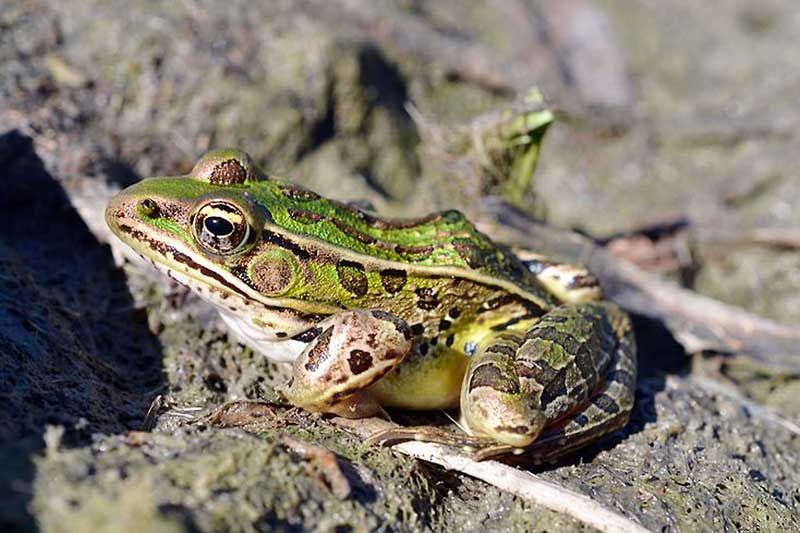May 14, 2015
By: Lorraine Julien
The Northern Leopard frog is easily identified by its irregular shaped greenish-brown spots that cover its back and legs. The frog’s underside is a creamy white colour with light coloured ridges on either side of its back. It’s a medium sized frog reaching a length of 3 to 5 inches (7.5 to almost 13 cm) nose to rump. Females are a bit bigger than males. You’ll probably see them around your cottage this spring as they are still fairly common in lake country. A very similar, but smaller, frog is the Pickerel frog, which has spots that are more angular (square).
The Northern Leopard frog ranges across most of northern North America except for the Pacific Coast. These frogs usually live near ponds and marshes but may venture into well-covered grasslands hence their other name, the Meadow frog. Though it is fairly wide spread, massive declines in its population began in the early 1970s, especially in Canada and the western U.S. The cause of the decline has not been determined but it’s likely a combination of factors: pollution, water acidity and habitat destruction.
This frog is not a fussy eater and will eat just about anything that will fit into its mouth. Patience really pays off - it can sit still for ages and wait for prey to wander by, then pounce with its powerful legs. Food on the menu includes: beetles, ants, flies, worms, smaller frogs (including their own species) and even small birds and garter snakes.
In turn, frogs of all types are a tasty treat for turtles, larger snakes, herons, raccoons and numerous other predators. In captivity, Leopard frogs have lived as long as 9 years but in the wild, probably 3 to 4 years would be the maximum. Their eggs are laid in a jelly-like mass usually attached to submerged vegetation.
The call of the Leopard frog is best described as a kind of chuckling sound made by rubbing wet hands on a balloon. It’s wonderful to see and hear our beautiful songbirds, but one of the best harbingers of spring (for me) is the sound of hundreds of frogs, and peepers singing their hearts out. Our resident bullfrog usually joins in with his base tones every so often.
If you want to help preserve amphibians and wetlands you should consider joining Frogwatch Ontario. You’ll learn a lot and help the environment as well. Frogwatch is a great community based conservation programme sponsored by the Toronto Zoo that helps to identify Ontario toads and frogs, their unique calls and the special places where they live. You can submit observations to:
www.torontozoo.com/adoptapond/FrogwatchOntario.asp
Your data will be used to update Ontario frog and toad distribution maps and identify important wetland habitats. Adopt-A-Pond can also be contacted by email – This email address is being protected from spambots. You need JavaScript enabled to view it. or by phone at 416-392-5999. If you are unsure which type of frog you are trying to identify, you can email a picture to Frogwatch. You’ll find these people are a great source of information – I know, they’ve certainly helped me in the past.
All frogs and toads are very active in spring and early summer when the males are calling to attract a mate. They are also seen throughout the summer, especially when froglets are emerging from the water. Dusk is the best time to monitor, but some species are also active during the day.
It’s really a good thing if you see lots of frogs around your cottage as it is an indication that the lake and surrounding area is healthy and relatively free of pollutants. Of course, the fact that frogs like to eat bugs is a real bonus but I would like it even better if they could eat mice – perhaps larger frogs could eat a small mouse. Wishful thinking on my part but I’ll have to check it out!
More Stories
- No Winner Yet in Catch The Ace But Fundraising Target Met
- South Frontenac Food Bank Opens Second Location in Battersea
- Sharbot Lake Pentecostal Church Anniversary - 1925-2025
- Frontenac Holistic Health Fair - September 20 At Storrington Centre
- Odd Year For Real Estate - But Sales Are Steady Year Over Year
- 193rd Kingston Fall Fair
- Kim Phuc - the Napalm Girl - To Visit Flinton In November
- South Frontenac Council - September 2
- Sticker Shock - EV Charging Station To Cost North Frontenac Township
- 30th Anniversary Verona Car Show

